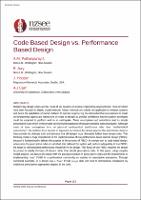| dc.contributor.author | M. Puthanpurayil, Arun | |
| dc.contributor.author | Jury, Rob | |
| dc.contributor.author | D. Hooper, John | |
| dc.contributor.author | Carr, Athol | |
| dc.date.accessioned | 2024-07-01T02:01:11Z | |
| dc.date.available | 2024-07-01T02:01:11Z | |
| dc.date.issued | 2024-04-09 | |
| dc.identifier.uri | https://repo.nzsee.org.nz/xmlui/handle/nzsee/2700 | |
| dc.description.abstract | Modern day design codes are the result of six decades of seismic engineering developments most of which have been focused on elastic modal methods. Modal methods are strictly not applicable to inelastic systems and hence the adaptation of modal methods to seismic engineering has demanded that assumptions be made on fundamental aspects to provide confidence that the systems developed could be expected to perform well in an earthquake. These assumptions lead to simple prescriptive rules which in the present day forms the backbone of most prescriptive code procedures. Although some of these assumptions have no physical/ mathematical justification other than “mathematical convenience”, the methods have become so ingrained in common day design practice that practitioners believe they provide the ultimate truth and demands that all designs must ultimately follow these simple rules. This thinking creates a huge impediment in the implementation of true performance based seismic design (PBSD), because it fundamentally defeats the purpose of the process of PBSD. In comparison to code-based design, where once the prescriptive rules are satisfied, it is believed we have an adequately performing system, in true PBSD, the target or demonstrated performance should drive the design. This focus of true PBSD, demands that the design be proven to satisfy the laws of physics rather than simple prescriptive rules. In this paper, we discuss the fundamental differences between these two design philosophies and the impediments in implementing them in a professional community so wedded to prescriptive procedures. | |
| dc.language.iso | en | |
| dc.publisher | New Zealand Society for Earthquake Engineering | |
| dc.relation.ispartofseries | 2024;113 | |
| dc.subject | Seismic performance, risk mitigation and resilience of new and existing structures | |
| dc.title | Code Based Design vs. Performance Based Design | |
| dc.type | Article | |

